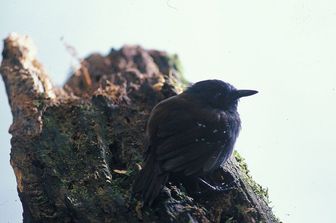Chestnut-backed Antbird
This is a common bird in the understory thickets of wet forest, especially at edges, along streams and in old treefall clearings, and in adjacent tall second growth. The female lays two purple or red-brown spotted white eggs, which are incubated by both sexes, in an untidy cup nest which is constructed from vines, plant fibre and dead leaves and placed low in vegetation. The male and female parents both feed the chicks.

The Chestnut-backed Antbird is classified as Least Concern. Does not qualify for a more at risk category. Widespread and abundant taxa are included in this category.
The Chestnut-backed Antbird, Myrmeciza exsul, is a passerine bird in the antbird family. It is found in humid forests in Central and South America (Chocó-Magdalena), ranging from eastern Nicaragua to western Ecuador. It mainly occurs in lowlands up to an altitude of 900 metres (3,000 ft) m, but locally it occurs higher. This is a common bird in the understory thickets of wet forest, especially at edges, along streams and in old treefall clearings, and in adjacent tall second growth. More
The Chestnut-backed Antbird is one of many secretive forest understory species that is far more often heard than seen. The song - a two- or three-note whistle - is a common feature of many lowland forests throughout the species’ range. Like most antbirds, the species has no special predilection for foraging at army-ant swarms, though it does so opportunistically when a swarm passes through a territory. More
A male Chestnut-backed Antbird staring me down on the jungle floor in Carara national park, a moist tropical forest on the Pacific coast. next (Dot-winged Antwren) last first previous (Black-hooded Antshrike) Chestnut-backed Antbird Copyright and usage info: My photos are free to use for non-commercial purposes only, provided that you retain the birdphotos.com imprint or visibly display © http://www.birdphotos.com with the image. For Internet usage, a link to http://www.birdphotos.com is required. More
Family : Thamnophilidae
Genus : Myrmeciza
Species : exsul
Authority : Sclater, 1859

